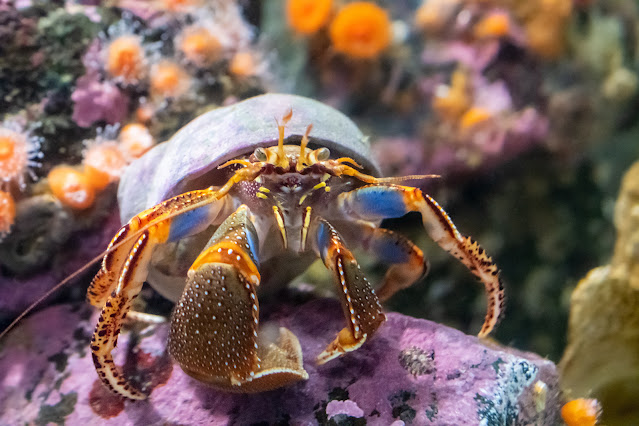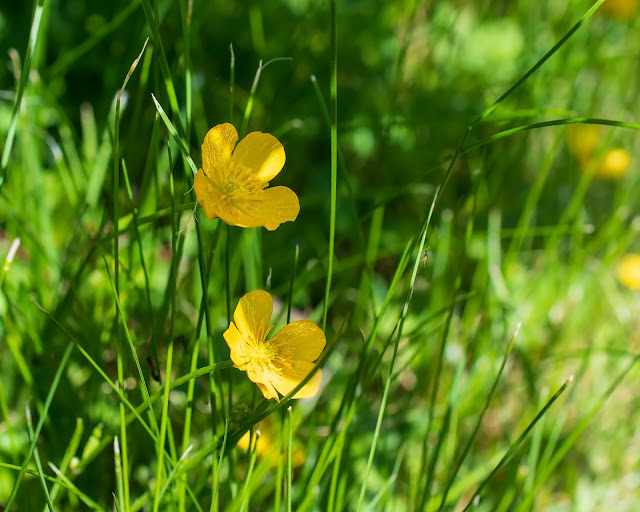I've been back to the little local aquarium again. This time the octopus was putting on a show, playing with balls, zooming back and forth, tying himself into knots, dancing in the current.
 |
| Playing Twister, I think. |
The octopus' eye has a rectangular pupil, like a goat's. They usually keep the pupil horizontal, no matter how they roll in the water.
Their eyes are better than ours, in some ways; they have more photoreceptors than we do, and they have no blind spot. They can detect the direction of polarized light; we can't. But with only one type of light receptor, they supposedly don't see colours. But then, how do they know how to change colour to match their environment for camouflage? Or for showing off to a prospective mate?
My camera lens breaks up the light along the edges between contrasting objects, giving me underwater bubbles or leaves against the sky, for example, with magenta tops and blue bottoms. A filter setting in my Photoshop erases some of this chromatic aberration, not all.
It seems that the octopus uses this "problem"; with those rectangular pupils, they scatter the light,
breaking it down into its various wavelengths. Somehow they manage to distinguish the colours by the pattern they form on the retina.
Intriguingly, using chromatic aberration to detect color is more computationally intensive than other types of color vision, such as our own, and likely requires a lot of brainpower, Stubbs said. This may explain, in part, why cephalopods are the most intelligent invertebrates on Earth. (Berkeley News)
~~~~~~~~~~~~
Regresé al acuario local esta semana. Esta vez, el pulpo se estaba divertiendo, jugando con una pelota, dando vueltas rápidas alrededor del tanque, haciéndose nudos, y bailando en la corriente del agua.
Foto: el pulpo. Parece que está jugando
"Twister".
El ojo del pulpo tiene la pupilo rectangular, como la de un chivo. Casi siempre la mantienen orientada horizontalmente, esté como esté torcido el cuerpo del animal.
Sus ojos son mejores que los nuestros, en algunos sentidos: tienen más fotorreceptores que nosotros, y sin nuestro punto ciego en el centro. Pueden reconocer la orientación de la luz polarizada; nosotros no podemos. Pero con un solo tipo de receptor de la luz, se ha creído que no ven los colores. Pero entonces, ¿cómo es que pueden cambiar de color para esconderse entre el medio ambiente? ¿Cómo es que el macho cambia de colores para atraer a su pareja?
Mi cámara divide los rayos de la luz en los bordes de objetos en colores en contraste, dejándome, por ejemplo, con burbujas en el agua, o con hojas contra el cielo pintadas de magenta en el borde superior, y de azul abajo. Un programa de Photoshop quita algo de esta aberración cromática, no del todo.
Parece que el pulpo toma ventaja de este "problema". Con esas pupilas rectangulares, la luz se dispersa, separándose por la longitud de onda. Y de alguna manera, se las arregla el pulpo para distinguir los colores por los diseños que forman en la retina.
Sorprendentemente, usar la aberración cromática para detectar el color es más intensivo con respeto a la computación que otros tipos de la visión cromática, tales como el nuestro, y probablemente requiere mucho poder mental — dijo Stubbs. Esto puede explicar, en parte, porque los cefalópodos son los invertebrados más inteligentes de la tierra. (Berkeley News)












































